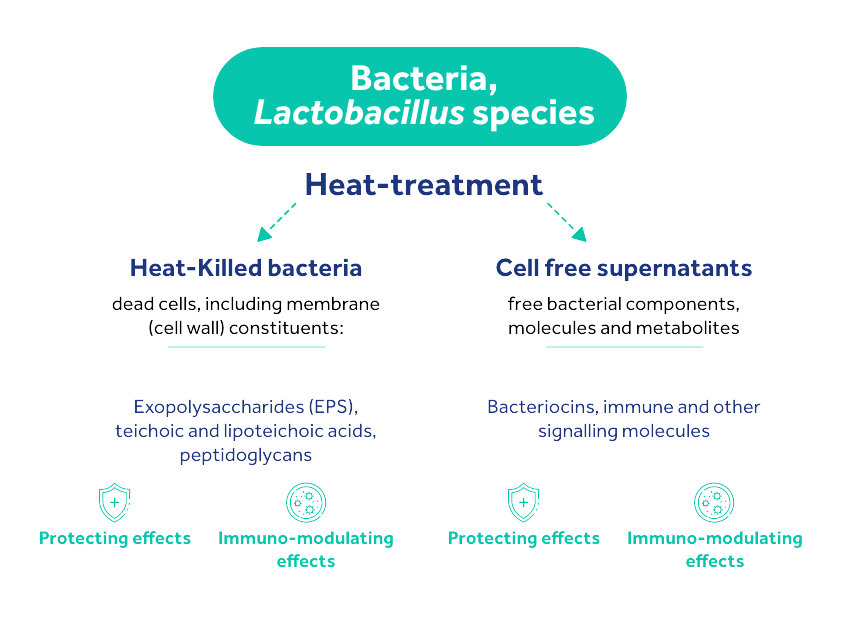Microbiota
and biotics
Solutions based on microbiota are not only a trend, they are also a deep reality. Indeed, current techniques have highlighted the mutual, symbiotic benefits between the microbiota and its host. With LBiome™, we believe this is the leading health solution of the 21st century. Before going into the issue of postbiotics, it is important to look at some essential notions and definitions.
Essential microbiota
Microbiota is defined as the bacteria, viruses and parasites colonizing our body. The most well-known microbiota among the general population is the intestinal microbiota. It is also the biggest with over 100 trillion germs¹. Nevertheless, we mustn’t forget that there are multiple microbiotas: pulmonary, cutaneous, urinary, ENT (Ear Nose Throat), and skin. The terms MICROBIOTA and MICROBIOME are frequently used interchangeably. MICROBIOTA is defined as the non-pathogenic bacteria, viruses and parasites colonizing our body whereas MICROBIOME is the catalogue of these microorganisms and their genes².
The interest in microbiota is growing, and its mechanisms are becoming clearer. As an example, we now know that the microbiota and immunity are closely linked. Indeed, much of the immune system is located in the digestive tract. There is considerable awareness of the importance of the microbiota. It is now well-known that the microbiota is involved in many diseases: an imbalance or lack of diversity of microbiota can lead to various health disorders or even chronic diseases, such as Inflammatory Bowel Disease (IBD)³ or depression4.
It is therefore essential to take care of the microbiota, particularly in terms of its diversity.

Biotic solutions
Biotic solutions have been designed to improve microbiota. With LBiome™, we like to present biotics as a real culture. In the following section we use the official International Scientific Association for Probiotics and Prebiotics (ISAPP) definitions.
Prebiotics are the substrate for the culture
They are defined by ISAPP as: “A substrate that is selectively utilized by host microorganisms conferring a health benefit"1
Prebiotics are non-digestible compounds2: plant fiber, vegetables, etc. These compounds, through their metabolization by bacteria, modulate the composition and/or activity of the gut microbiota. Therefore, they confer a beneficial effect on the host.
Probiotics are the seed
Probiotics have been defined by World Health Organization for more than 20 years as live microorganisms. In 2013, ISAPP reviewed the original definition: “Live microorganisms that, when administered in adequate amounts, confer a health benefit on the host”3.
Postbiotics are the harvest
Postbiotics are either:
- non-viable bacterial products
- metabolic products from microorganisms
Both have a biological activity in the host. ISAPP has formulated the following definition: “A preparation of inanimate microorganisms and/or their components that confers a health benefit on the host."4
To go further, a symbiotic is defined by ISAPP as “a mixture comprising live microorganisms and substrate(s) selectively utilized by host microorganisms that confers a health benefit on the host.”9 Currently, products associating prebiotics and probiotics are the most common on the market.
All about
Postbiotics
What are postbiotics?
Although the term “postbiotics” is rather new, the concept has been studied for almost 20 years. Indeed, studies and experts sometimes use different terms, such as:
• Heat-killed bacteria or its more precise equivalent tyndallized, naming the sterilization process by discontinuous heating (60-80°C)
• Non-viable bacteria. Indeed, heat-treatment is one of the processes that can be used to kill bacteria, but there are others, like sonication.
The term postbiotics is becoming more and more widespread, especially in the field of research. In 2019, for example, it was 15 times more common than the alternative terms on PubMed. The term is gaining in importance and recognition.
When we talk about postbiotics, all the components are involved in the benefits and have particular effects. Indeed, you have on the one hand the heat-killed bacteria: the dead cells, including the membrane constituents. On the other hand, the cell free supernatants are also involved. These components include free bacterial components, molecules and metabolites. For example, these are bacteriocins and immune molecules.

As a pioneer in postbiotics, we have thoroughly explored and studied their benefits to provide you with the best: LBiome™. LBiome™ is the ultimate postbiotic, containing everything: dead cells, membrane constituent, but also supernatant with all molecules and metabolites produced during fermentation.
Postbiotics: going beyond probiotics
1. HEALTH BENEFITS
They have positive impacts on health, with two main areas of application:
• A barrier effect protecting cells, including membrane walls as well as their content, against pathogens.
• Immuno-modulating effects with anti-inflammatory effects.
2. PHYSIOLOGICAL BENEFITS
• Active molecules are released in high concentration.
Therefore, they are able to act more directly on the microbiota and intestinal epithelial cells.
• Beneficial effects can be more complex due to the loss of viability and cell lysis.
3. SAFETY
Postbiotics are safe ingredients to include in your finished products:
• There is no risk of translocation from gut lumen to blood, especially in vulnerable subjects.
• There are no risks of acquisition and retransfer of antibiotic resistance genes.
4. CONVENIENCE
Last, but not least, postbiotics are easy to use.
• Being highly stable ingredients, they are easier to standardize, transport and store.
Indeed, unlike probiotics, postbiotics are not “living” ingredients and therefore are completely reliable.
the ultimate postbiotic ingredient
Sources:
1. INSERM, 2016
2. ISAPP, “Microbiome”, consulted on January 25th 2021 at: https://isappscience.org/for-scientists/resources/microbiome/
3. Nanjundappa RH, Ronchi F, Wang J et al. A Gut Microbial Mimic that Hijacks Diabetogenic Autoreactivity to Suppress Colitis. Cell, 2017 DOI: 10.1016/j.cell.2017.09.022
4. Liang S, Wu X, Hu X, Wang T, Jin F. Recognizing Depression from the Microbiota⁻Gut⁻Brain Axis. Int J Mol Sci. 2018 May 29;19(6):1592. doi: 10.3390/ijms19061592. PMID: 29843470; PMCID: PMC6032096.
5. Gibson, G., Hutkins, R., Sanders, M. et al. Expert consensus document: The International Scientific Association for Probiotics and Prebiotics (ISAPP) consensus statement on the definition and scope of prebiotics. Nat Rev Gastroenterol Hepatol 14, 491–502 (2017). https://doi.org/10.1038/nrgastro.2017.75
6. Rebeca Martin et Philippe Langella – Emerging Health Concepts in the Probiotics field: Streamlining the definitions – Frontiers in Microbiology – 10; 1047
7. Hill, C., Guarner, F., Reid, G. et al. The International Scientific Association for Probiotics and Prebiotics consensus statement on the scope and appropriate use of the term probiotic. Nat Rev Gastroenterol Hepatol 11, 506–514 (2014). https://doi.org/10.1038/nrgastro.2014.66
8. Salminen, et al. Expert consensus document: The International Scientific Association for Probiotics and Prebiotics (ISAPP) consensus statement on the definition and scope of postbiotics
9. Swanson, K.S., Gibson, G.R., Hutkins, R. et al. The International Scientific Association for Probiotics and Prebiotics (ISAPP) consensus statement on the definition and scope of synbiotics. Nat Rev Gastroenterol Hepatol 17, 687–701 (2020). https://doi.org/10.1038/s41575-020-0344-2
10. Piqué N. et al. Health Benefits of Heat-Killed (Tyndallized) Probiotics: An Overview. International Journal of Molecular Sciences 2019;20(10):E2534.